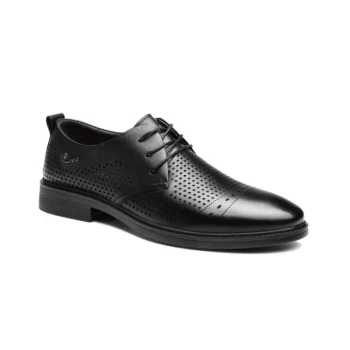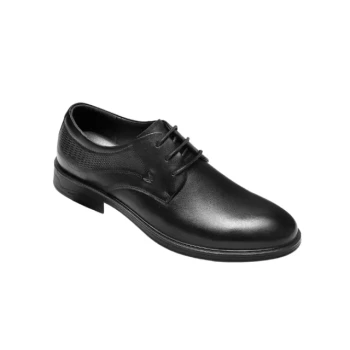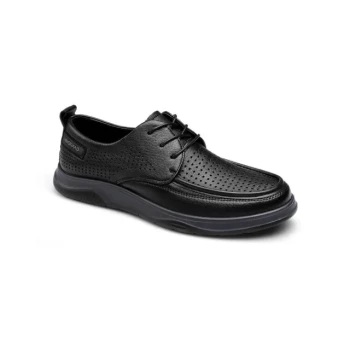At its core, bi-cast leather is a budget-friendly material made by taking the lower-quality, fibrous part of a hide, known as split leather, and applying a synthetic polyurethane coating to its surface. This coating is then embossed with a texture to mimic the appearance of more expensive top-grain leather, resulting in a uniform and consistent finish.
The central feature of bi-cast leather is its ability to offer the visual aesthetic of premium leather at a significantly lower cost. However, this is achieved by sacrificing the essential functional qualities that define genuine leather: durability, breathability, and the capacity to age gracefully.
How Bi-cast Leather is Made
Understanding the construction of bi-cast leather is key to understanding its properties. The process directly creates the material's signature characteristics and its limitations.
The Foundation: Split Leather
Bi-cast leather does not use the top layer of the animal hide. Instead, it uses the "split," which is the less durable, fibrous section left after the stronger, top-grain layer has been removed.
The Synthetic Surface
A layer of polyurethane (a type of plastic) is applied over this split leather base. This synthetic coating is what the wearer sees and touches, not the actual leather hide.
The Embossed Finish
Finally, this polyurethane coating is heat-pressed with an artificial grain pattern. This process creates a perfectly uniform and flawless look, which is a key differentiator from natural leather's unique imperfections.
Key Features for Footwear
When evaluating bi-cast leather for shoes, its features present a clear set of compromises compared to traditional leather.
Appearance and Consistency
Bi-cast leather offers a completely uniform appearance with no natural blemishes, creases, or color variations. While some prefer this flawless look, it lacks the unique character and depth of high-quality, natural leather.
Durability and Longevity
The material's durability is limited by its synthetic coating. Over time, with flexing and stress from walking, this polyurethane layer is prone to cracking, peeling, or delaminating from the split leather base. It does not possess the inherent strength of full-grain leather.
Breathability and Comfort
This is a critical drawback for footwear. The plastic coating effectively seals the leather's pores, drastically reducing its natural breathability. This can trap moisture and heat, leading to less comfortable wear, especially over long periods.
Aging and Patina
Unlike high-quality leather that develops a rich, desirable patina over time, bi-cast leather simply wears out. It does not improve with age; instead, its surface breaks down and can look worn and damaged.
Understanding the Trade-offs
The choice to use or purchase bi-cast leather shoes comes down to a clear trade-off between price and performance.
The Cost Advantage
The primary and most compelling feature of bi-cast leather is its affordability. It allows manufacturers to produce shoes with a leather-like look at a fraction of the cost of using genuine top-grain materials.
The Feel and Flexibility
Bi-cast leather has a stiffer, more "plastic" feel than natural leather. It does not stretch, mold, or conform to the foot in the same way, which can impact overall comfort and fit.
The Lack of Repairability
When genuine leather gets scuffed, it can often be conditioned, polished, and repaired. When the polyurethane coating on bi-cast leather is scratched or starts to peel, it is nearly impossible to restore it to its original condition.
Making the Right Choice for Your Shoes
Your decision should be based on your priorities for the footwear.
- If your primary focus is affordability and a consistent look for occasional wear: Bi-cast leather provides the aesthetic of leather for a low price, making it a viable option for shoes you don't plan to wear frequently.
- If your primary focus is comfort, durability, and long-term value: Investing in genuine full-grain or top-grain leather is the superior choice, as it will last longer, be more comfortable, and age better.
Ultimately, choosing bi-cast leather means prioritizing immediate cost and a uniform appearance over the performance, comfort, and longevity inherent in traditional leather.
Summary Table:
| Feature | Description |
|---|---|
| Material | Split leather base with a synthetic polyurethane coating. |
| Appearance | Uniform, flawless, and consistent; mimics top-grain leather. |
| Primary Benefit | Highly affordable, offering a leather-like look at a low cost. |
| Key Drawbacks | Less durable, prone to peeling/cracking, low breathability, stiff feel. |
| Best For | Occasional wear or budget-conscious purchases where long-term durability is not the priority. |
Ready to source high-quality footwear?
As a large-scale manufacturer, 3515 produces a comprehensive range of footwear for distributors, brand owners, and bulk clients. Our production capabilities encompass all types of shoes and boots, ensuring you get the right material, durability, and value for your specific market needs.
Contact our team today to discuss your production requirements and get a quote!
Related Products
- Wholesale Comfort Leather Business Shoes with Dial Lacing System
- Durable Rubber-Soled Utility Shoes for Wholesale & Custom Brand Manufacturing
- Custom Manufactured Air Cushion Leather Business Shoes for Wholesale
- Wholesale Breathable Training Shoes Custom Athletic Footwear Manufacturer
- Factory Direct Wholesale Leather Comfort Shoes with Dial Closure
People Also Ask
- How can crocodile-inspired leather dress shoes make a statement at formal events? Command Attention with Bold Style
- What are the environmental benefits of choosing real leather shoes? Durability and Waste Reduction
- What are the key features of high-quality leather in shoes? Invest in Durability and a Perfect Fit
- How does top-grain leather differ from full-grain? Choose the Right Leather for Your Products
- Are sneakers acceptable in a business casual workplace? How to Choose the Right Style



















